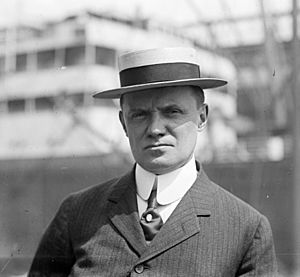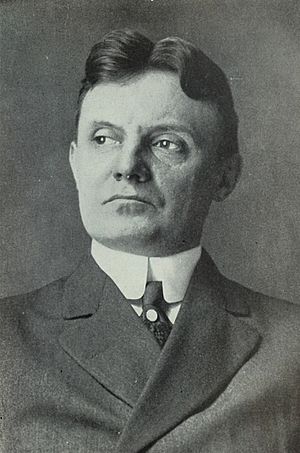Charles Seymour Whitman facts for kids
Quick facts for kids
Charles Seymour Whitman
|
|
|---|---|

Whitman in 1910
|
|
| 41st Governor of New York | |
| In office January 1, 1915 – December 31, 1918 |
|
| Lieutenant | Edward Schoeneck |
| Preceded by | Martin H. Glynn |
| Succeeded by | Alfred E. Smith |
| New York County District Attorney | |
| In office 1910–1913 |
|
| Preceded by | William Travers Jerome |
| Succeeded by | Charles A. Perkins |
| Personal details | |
| Born | September 29, 1868 Hanover, Connecticut, U.S. |
| Died | March 29, 1947 (aged 78) New York City, U.S. |
| Political party | Republican |
| Spouses |
Olive Hitchcock
(m. 1908; Thelma Somerville Cudlipp
(m. 1933) |
| Relations | John Russell Whitman (grandson) |
| Education | Amherst College (B.A.) New York University School of Law (LL.B.) |
Charles Seymour Whitman (born September 29, 1868 – died March 29, 1947) was an American lawyer and politician. He served as the 41st Governor of New York from 1915 to 1918. Before becoming governor, he was a New York County District Attorney and a judge. He also represented New York at the 1916 Republican National Convention.
Contents
Charles Seymour Whitman: A Leader for New York
Early Life and Education
Charles Seymour Whitman was born in Hanover, Connecticut, on September 29, 1868. His parents were John Seymour Whitman and Olivia (Arne) Whitman.
He went to Amherst College and graduated in 1890. After that, he studied law at New York University School of Law, finishing in 1894. Later that year, he became a lawyer and started his own law practice in New York City.
Becoming a Public Servant
In 1901, Whitman began his career in public service. He was appointed as an assistant lawyer for New York County. He was then elected as a city magistrate, which is a type of judge. In this role, he created the Night Court. This court allowed people arrested at night to have their cases heard right away.
In 1907, Governor Charles Evans Hughes appointed Whitman as a judge for the Court of Sessions. The next year, Governor Hughes asked him to help investigate election problems in northern New York.
Fighting Crime in New York City
In 1909, Whitman was elected as the New York County District Attorney. This job meant he was the chief prosecutor for New York County. He made sure his staff had a presence in the city magistrate's office. He was also known for strongly prosecuting people who committed arson, which helped reduce such fires.
As District Attorney, Whitman became very well-known for handling a big case involving a police lieutenant named Charles Becker. This case showed how some police officers were involved in corrupt activities with criminals. Whitman's work led to important changes and reforms within the police department.
Whitman also received praise for his handling of other cases. These included a case involving a priest named Hans Schmidt and his prosecution of a "poultry trust" (a group controlling chicken prices). He also worked on cases of election fraud. Because of his success, he was re-elected as District Attorney in 1913 with almost all the votes.
Governor of New York
In 1914, Charles Whitman was elected as the 41st Governor of New York. He served from January 1915 to December 1918. His main goal as governor was to improve the state's finances. He reorganized many state departments and looked closely at the salaries of state employees.
In 1915, he joined the Empire State Society of the Sons of the American Revolution. This group is for people whose ancestors helped during the American Revolution.
In 1916, Whitman was re-elected as governor. He won against Judge Samuel Seabury. After his re-election, he sent a report about his first term to every registered voter. This report included updates from his state departments. He also started a state police force.
When the United States entered World War I, Governor Whitman created a new state guard. This was to replace the National Guard, which was serving overseas in France. In 1916, he was chosen to lead the Republican National Convention. There, he encouraged the nomination of former New York Governor Hughes for President of the United States. In 1917, he ordered the creation of the New York State Police. He chose George Fletcher Chandler, a doctor and major in the National Guard, to organize and lead this new force.
In 1918, Whitman lost his re-election bid to Al Smith. Smith was then the President of the New York City Board of Aldermen.
Personal Life and Family
In 1908, Charles Whitman married Olive Hitchcock (1880–1928). They had two children:
- Olive Whitman
- Charles S. Whitman, Jr. (1915–2002), who also became a New York Judge.
After his first wife passed away in 1928, he married Thelma Somerville (née Cudlipp) Grosvenor in 1933. She was the widow of Edwin Prescott Grosvenor.
Charles Seymour Whitman passed away on March 29, 1947, in Manhattan.
Family Legacy
His grandson, John Russell Whitman (1944–2015), married Christine Todd (born 1946). Christine Todd Whitman later became a Republican Governor of New Jersey. She also served as the Administrator of the Environmental Protection Agency.


